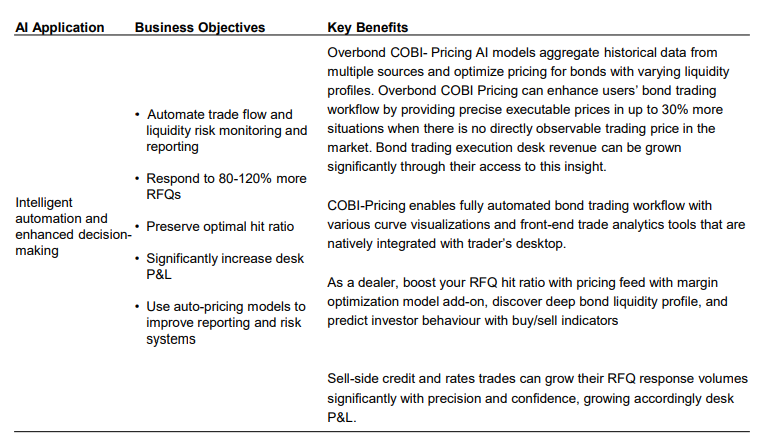OVERVIEW
Trading Automation
Sell-side dealers and buy-side asset managers are rapidly embracing artificial intelligence applications to price fixed income securities algorithmically in live trading environments or for purposes of end of day reconciliation. The current fixed income capital market data flows are inefficient in many respects to enable robust coverage and precision for AI bond pricing. Markets remain heavily reliant on segregated and manual data operations between counterparties creating disparate data sets. These disparate data sets cause the market to suffer from information asymmetry and decentralization. As a result, insight from available data is fragmented and disseminated through manual exchanges between counterparties, which furthers the creation of disparate data sets.
A bond, the most prominent fixed income security, is an investment of a year or more that provides investors with fixed or variable interest payments (coupon payments) on a fixed payment schedule (e.g. semiannually or annually) and full principal payment at the end of the bond’s life (maturity). The major issuers of bonds are corporations and governments that aim to raise substantial amounts of capital not readily available through other fundraising options.
The primary problem that the trader faces is due to the low confidence in prices suggested by market data sources such as, Bloomberg CBBT and other third-party applications that are currently used:
- Overbond COBI-Pricing, AI bond pricing feed can price bonds automatically with live refresh rates measured in sub 3 second range enabling automated trading workflow. Models can price 30% more bonds with low liquidity profile greatly increasing coverage and trade flow
- COBI-Pricing can systematically price a large number of liquid and illiquid securities, issuer names, and identify pricing tension metrics across large coverage book systematically
These factors lead to low confidence in the suggested prices and traders must constantly spend a great deal of time and effort in manually adjusting prices based on prior knowledge and intuition.
COBI-Pricing, Overbond AI modeling techniques share many similarities with classic statistical modeling techniques starting from the fact that they both deal with volumus data. However, the key difference between statistical techniques and AI models Overbond applies is the goal of these approaches. While statisticians start with a set of known assumptions that are given to the model and best explain the expected behavior of the financial outcome in consideration, AI techniques rather aim at finding by themselves the method (with underlying assumptions that are unknown) that best predicts the outcome in consideration.
- Overbond COBI-Pricing, AI bond pricing feed can price bonds automatically with live refresh rates measured in sub 3 second range enabling automated trading workflow. Models can price 30% more bonds with low liquidity profile greatly increasing coverage and trade flow
- COBI-Pricing can systematically price a large number of liquid and illiquid securities, issuer names, and identify pricing tension metrics across large coverage book systematically

Interoperability
Technology has been enabling automation in equities for two decades. It’s now poised to enhance the bond market. Increases in fixed income electronic trading volumes have driven enhancements in trading desk operations over the previous five years, making the lives of traders easier in today’s natively digital world. This is now possible because of three factors: AI models such as COBI-Pricing LIVE that can price fixed income securities and score their liquidity; speed from cloud computing; and protocols that allow for data aggregation and increased interoperability of the systems used in trading workflows.
Interoperability is the ability of different systems or programs to communicate with each other, exchange information and use that information. It is particularly important for bringing automated trading to the sell-side and buy-side desks because these desks traditionally have five to 10 preexisting systems necessary to conduct trading. Automating trading workflow is possible because COBI-Pricing Live is fully interoperable with the existing technologies on the desk.
- Overbond’s COBI-Pricing LIVE uses three layers of interoperability to automate trading: it ingests and aggregates data from multiple sources, it integrates with the legacy systems on the desk, and it communicates with electronic trading venues
- COBI-Pricing LIVE aggregates data from multiple sources including vendor feeds, internal historical records and settlement-layer volume information for OTC trades from providers such as Euroclear. To ingest data from these diverse sources requires interoperability between COBI-Pricing LIVE and the systems that provide the data
- Interoperability with electronic trading venues allows for the ability to trade on multiple platforms and opens the door for smart order routing, allowing desks to optimize execution
COBI-Pricing LIVE now offers protocol and system agnostic integration with venues and e-trading systems used by sell-side and buy-side trading desks through RA Platform 3.0, an open API enterprise software platform from Rapid Addition, a provider of electronic trading middleware.
IN THE PRESS
"Overbond Ltd., the first end-to-end fixed income markets fintech platform for AI predictive analytics, has launched COBI Pricing, a new proprietary bond pricing and liquidity risk management automation solution. COBI (Corporate and Government Bond Intelligence) is a comprehensive..."










